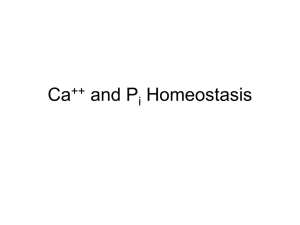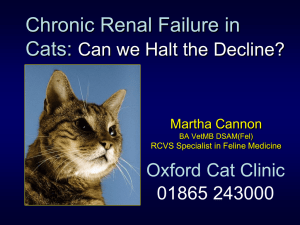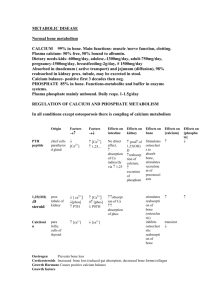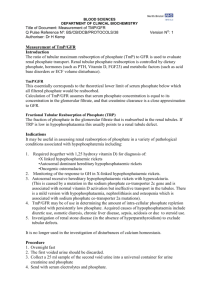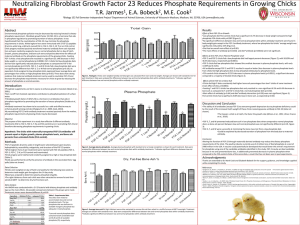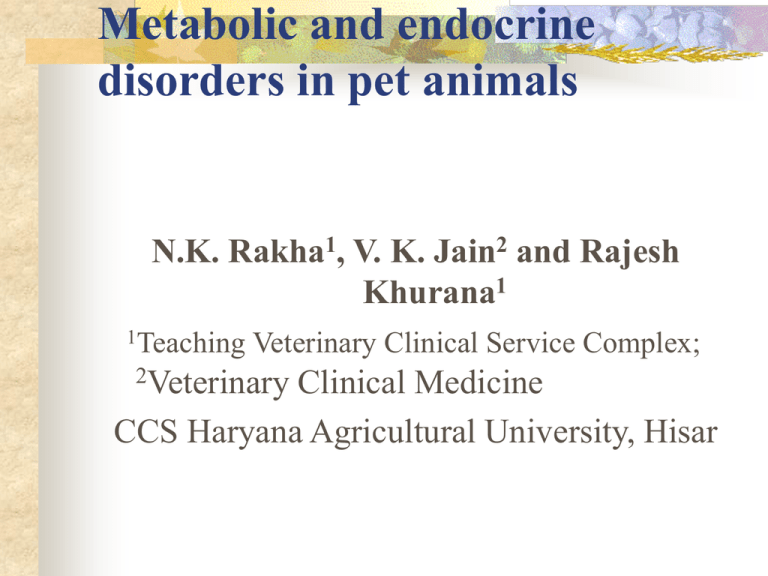
Metabolic and endocrine
disorders in pet animals
N.K. Rakha1, V. K. Jain2 and Rajesh
Khurana1
1Teaching
Veterinary Clinical Service Complex;
2Veterinary
Clinical Medicine
CCS Haryana Agricultural University, Hisar
Metabolic and endocrine disorders
1.
2.
3.
4.
5.
6.
7.
8.
9.
Rickets
Osteomalacia
Osteoporosis
Hypo-phosphataemia
Hyper-phosphataemia
Diabetes mellitus
Diabetes insipidus
Nutritional secondary hyper-parathyroidism
Renal secondary hyper-parathyroidism
1. Rickets
Vitamin D is required for orderly
growth & mineralization of
epiphysis (growth plate).
Young animals fed deficient diets
or housed indoors without
exposure to UV radiation
develop rickets.
Pathogenesis
There may be a decrease in serum
Ca & P levels due to impaired
intestinal absorption.
Mineralization of cartilaginous
matrix fails to occur and physis
become irregularly thickened.
P deficiency also will result in
rickets because of the failure to
maintain an adequate ion product
of serum Ca and P at the zones of
mineralization in bone.
P deficiency will not results in
hypocalcaemia & serum levels
will be normal or increased.
Clinical findings
Long bones of the legs get bent.
There is beading over ribs and
long bones
In severe cases there is lameness
associated with enlargement of the
ends of fast growing bones and
deformities of the weight bearing
long bones.
Clinical diagnosis
Lameness and enlargement of the
joints is more commonly due to
chronic polyarthritis and in young
large dogs due to hypertrophic
osteodystrophy.
Radiograph of rachitic bones show
wide
growth
plates
and
demineralization.
Treatment
Administration of
Vitamin D,
Ca &
P
leads to re-establishment of normal
calcification in osteoid on bone
surfaces and physes.
2. Osteomalacia
It literally means, “softening of bones”.
Characterized by defective mineralization of
osteoid (bone matrix) in mature bone due to
deficiency of Vit D or P.
Much less inhibition of bone matrix formation
compared to impairment of matrix
mineralization.
Adequate local conc. of P & Ca is necessary
for proper deposition of minerals at
mineralization front.
Pathogenesis
P deficiency inhibits normal osteoblast
function and reduces the Ca – P ion
product.
Vitamin D stimulates Ca and P
absorption from the intestine and help
in normal osteoblast function.
Diagnosis
Diagnosis of osteomalacia required
interpretation of bone pain, serum
Ca, P & Vit D conc.
Radiography and bone biopsy will
also help in diagnosis.
Osteomalacia may also occur during
fat malabsorption syndrome due to
inhibition of absorption of Ca, P &
Vit D.
3. Osteoporosis
It is defined as a reduction in bone
density that predisposes bone to
fracture (however, bone is structurally
normal).
It may occur as a result of malnutrition,
deficiency of Ca or P, during protein
wasting diseases (e.g. parasitism),
local or generalized skeletal disuse or
as an aging change.
4. Hypo-phosphataemia
[ Hypo-phosphataemia can be termed when serum
P conc. < 3 mg/dl in dogs and cats.]
Etiology: It may result from
1.
2.
3.
Decreased absorption of phosphate from the
intestines,
Increased urinary phosphate excretion e.g.
hyper-parathyroidism or
Shift of phosphate from the extracellular to
intracellular compartment e.g. after the
treatment of Diabetic keto acidosis.
Clinical features
1.In
most of cases it affects haematological
& neuromuscular system in dogs & cats
2.Hemolytic anaemia is the most common
sequel of the hypo-phosphataemia and
may be life threatening in the absence of
treatment
3.Other signs observed may be weakness,
ataxia and seizures.
Treatment
Remove the underlying cause.
1. Phosphate may be administered orally
(Potassium or Sodium salt, according
to the situation.
2. In severe cases i.v. in NSS. (0.01 0.03 mmol/kg/hr).
3. Avoid hyperphosphataemia; therefore
frequent monitoring of phosphate is
advisable.
5. Hyperphosphataemia
When serum phosphate (PO4) conc. is greater
than 6.5. mg/dl in adult dogs.
Dogs and cats under 6 months of age normally
have higher serum phosphate concentration
than adults.
Etiology
It can result from increased intestinal
phosphate absorption, decreased
phosphate excretion in urine, or shifting
of phosphate from intra-cellular to
extra-cellular compartment.
2.Most common causes in dogs/cats are
renal failure, Vit D toxicosis (i.e.
cholecalciferol / rodenticide toxicosis)
and hypophosphataemia.
1.
Clinical features
1.
2.
3.
4.
5.
It reflects some other underlying disease.
By itself, it usually doesn’t cause clinical
signs.
An acute increase in serum phosphate
level may cause hypo-calcaemia.
Sustained hyperphosphataemia can cause
20 hyper-parathyroidism, fibrous osteodystrophy and metastatic calcification in
exosteoseous sites.
Sustained hyperphosphataemia is usually
caused by renal insufficiency or hypoparathyroidism.
Treatment:
1.
2.
3.
Treat underlying disease (renal
failures)
Give protein restricted diets
Oral administration of phosphate
chelating gels. (Aluminium
preparations)
6. Diabetes mellitus
Insulin dependent Diabetes mellitus
is characterized by
1.
2.
3.
Hypo-insulinaemia,
Poor glycaemic control in response to
diet or treatment with oral hypoglycaemic drugs or both and
Need of exogenous insulin to
maintain the glycaemic control.
Etiology
Causes are poorly characterized & multi-factorial e.g.
1.Genetic
pre-disposition,
2.Infection,
3.Insulin antagonistic diseases and drugs,
4.Obesity,
5.Immune mediated pancreatitis.
This results in impaired transport of circulating
glucose into most of cells, accelerated hepatic
gluconeogenesis and glycogenolysis.
In turn, this leads to hyperglycaemia,
glycosuria, polyuria, polydipsia,
polyphagia, weight loss, ketoacidosis (over
production of ketone bodies to compensate
for the underutilization of blood glucose).
A transient or reversible form of IDDM
may be seen in bitches in diestrus due to
insulin antagonism.
Clinical features
1.
2.
3.
4.
5.
6.
Peak prevalence at 7-9 yr of age (range 4-14 yrs).
Juvenile diabetes (<1 year) is uncommon.
Females suffer twice than males.
Breed disposition is observed
Pulik, Cairn Terriers, Miniature Pinschers,
poodles, Dachshunds, Miniature schnanzers and
beagles are more affected
Cocker spaniel, German Shephard, Collies,
Pekingese, Rotweilers, and Boxers are relatively
less affected.
History:
1.
2.
3.
4.
Hyperglycaemia results in glycosuria,
which may be reflected as polyuria,
polydipsia, polyphagia and weight loss.
There is frequent need to change the litter.
There is development of sudden blindness
or rear limb weakness, plantigrade posture
(hocks touch the ground when cat walks,
differentiate from arthritis).
Later on, animal may develop ketonaemia,
metabolic acidosis or diabetic ketoacidosis
Clinical features
1.
2.
3.
4.
Animal may be obese or in good physical
condition.
In later stages, wt. loss may be there or it
may be due to some other concurrent
disease like pancreatic exocrine
insufficiency, hyper thyroidism.
Hepatic lipidosis results in hepathomegaly.
Fasting hyperglycaemia (> 130 mg/dl) &
glycosuria are important laboratory
findings. Cataract is also a coomon clinical
finding in diabetic dogs.
Treatment :
Important goal is to maintain near
normoglycaemia with help of
1. Medicines (sulfonyl ureas,
glipizide, biguanides),
2. Insulin,
3. Diet &
4. Exercise.
7. Diabetes insipidus
Arginine vasopressin (AVP) has an important role
in water balance, renal water resorption, urine
production and concentration.
It is stored and secreted from the posterior pituitary
gland and acts on distal tubular and collecting
duct cells of kidney.
Diabetes inspidus (DI) is caused as a result of
defective synthesis or secretion of AVP (Central
DI) or due to inability of the renal tubules to
respond to AVP (Nephrogenic DI). There is no
age, breed or sex related predilection for DI.
Etiology
The causes of CDI are trauma, idiopathic,
neoplasia, pituitary malformation, cyst,
inflammation etc.
While NDI may be primary idiopathic, primary
familial (huskies) or secondary acquired renal
insufficiency or failure, hyperadrenocorticism,
hypoadrenocorticism, hepatic insufficiency,
pyometra, hypercalcaemia, hypokalaemia, post
obstructive diuresis, normo-glycemic glucosuria,
hyper-thyroidism.
Clinical signs
1.
2.
3.
Polyuria and polydipsia are the
hallmark signs of diabetes
inspidus.
Nervous signs may be seen in
animals in which hypothalamic or
pituitary tumor may be growing in
the head.
The urine sp. gravity is 1.005
(Range 1.001 – 1.012)
Treatment:
Synthetic analog of vaso-pressin as
nasal spray or eye drops is
reported to be very effective (1-4
drops o.d. or b.i.d.) or s.c.
administration may be practiced
(0.5 – 2 µg, o.d. or b.i.d.)
8. Nutritional secondary hyperparathyroidism
It is nutritional/ metabolic disorder caused by
elevation of parathyroid hormone (PTH),
usually secondary to poor nutrition.
All meat or all grain diet is rich in P which is
responsible for this disorder.
Low calcium and Vitamin D and
malabsorption also cause hypocalcaemia.
Increased PTH causes bone resorption, & Ca,
thus, mobilized is transferred to extracellular fluid.
Depletion of bone osteoid leads to
deformities, fractures and loss of structural
support.
Clinical Picture:
1.
2.
3.
4.
Young animals suffer lameness/ bone
deformities
Spontaneous fractures of long bones or
vertebrae occur many times.
Increase in serum phosphate, alkaline
phophatase & PTH is there but Ca may
be normal or decreased.
Radiography show systemic bone
resorption/ fracture
Treatment:
1.
2.
3.
Ca supplementation & dietary
correction is must.
Restrict the movements to
prevent fractures.
External splint should be
applied.
9. Renal Secondary hyper-parathyroidism
1.
2.
This is caused by increased PTH
levels associated with congenital/
acquired renal insufficiency.
Due to impaired P excretion and
diminished conversion of Vit. D to its
active form results in hypocalcaemia,
which stimulates release of PTH and
subsequent bone resorption
(Osteomalacia)
Clinical Picture
Due to uraemic syndrome animal will show
polydipsia/ polyuria, vomition, diarrhea, weight
loss, anorexia, loosening of teeth etc.
Problem in mastication may occur (rubber jaw)
Locomotory lesions are not frequently seen.
Soft tissue calcification in lungs, kidneys, stomach
and heart may be found.
Increased BUN, serum creatinine, phosphatase and
plasma PTH are found.
Bone resorption (especially of skull) is observed in
radiograph.
Treatment
Treatment for renal failure should be
instituted and also to reduce BUN,
creatinine and phosphate.
1. Restrict protein diet
2. Oral phosphate binding gels (30-90
mg/kg/ day)
3. Vit D3 (Calcitriol) 0.025µg/kg/day-po
4. Ad lib fresh drinking water should be
provided.




